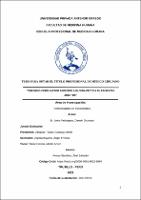Obesidad como factor asociado a úlcera péptica en pacientes adultos

View/
Download
(application/pdf: 706.8Kb)
(application/pdf: 706.8Kb)
Date
2021Author(s)
Leiva Velásquez, Darwin Jhonatan
Metadata
Show full item recordAbstract
Determinar si la obesidad está asociada al desarrollo de úlcera péptica
en pacientes adultos del hospital Víctor Lazarte Echegaray en el periodo enero
2016- enero 2018.
Material y métodos: Esta investigación corresponde a un diseño tipo
observacional, retrospectivo, analítico de casos y controles. Se abarco a 385
pacientes que cumplen con los criterios de inclusión, para lo cual se obtuvo el
consentimiento del hospital Víctor Lazarte Echegaray para el acceso de las
historias clínicas de pacientes atendidos en el servicio de Medicina Interna,
atendidos entre enero del 2016 y enero del 2018, divididos en casos (con ulcera
péptica) y controles (sin ulcera péptica). Posteriormente se recolecto la base de
datos en el programa Microsoft Excel 2016, luego se procedió a analizarlos con
el programa IBM SPSS Statistics 25 y según un análisis bivariado, se aplicó la
prueba de Chi cuadrado, para calcular diferencia estadística. Finalmente se
realizó una regresión logística con las variables con significancia estadística en
el bivariado.
Resultados: De la población total de 385 pacientes. La frecuencia de ulcera
péptica en pacientes con obesidad fue de 53(69%). La frecuencia de ulcera
péptica en pacientes sin obesidad fue de 31%. Donde se determinó que la
obesidad es factor asociado para desarrollar la enfermedad de Ulcera péptica
con un OR (IC 95%): 15,69 (8,70 - 28,30). En el análisis bivariado se reconocen
a las variables: obesidad, edad, alcoholismo, tabaquismo, Diabetes mellitus,
HTA y uso de anticoagulantes como factores asociados ulcera péptica. Pero en
el análisis multivariado las únicas variables con significancia estadística son la
obesidad con OR (IC 95%): 16,32 (8,87 - 30,03) y el uso de anticoagulantes con
OR (IC 95%): 9,79 (2,60 - 36,84).
Conclusión: La obesidad si se asocia al desarrollo de ulcera péptica en
pacientes adultos del hospital Víctor Lazarte Echegaray de la ciudad de Trujillo To determine if obesity is associated with the development of peptic
ulcer in adult patients at the Víctor Lazarte Echegaray hospital in the period
January 2016- January 2018.
Material and Methods: This study corresponds to an observational,
retrospective, analytical case-control design. 385 patients who met the inclusion
criteria were included, for which consent was obtained from the Víctor Lazarte
Echegaray hospital for access to the medical records of patients treated in the
Internal Medicine service, treated between January 2016 and January 2016.
2018, divided into cases (with peptic ulcer) and controls (without peptic ulcer).
Subsequently, the database was collected in the Microsoft Excel 2016 program,
then they were analyzed with the IBM SPSS Statistics 25 program and according
to a bivariate analysis, the Chi-square test was applied to calculate statistical
difference. Finally, a logistic regression was performed with the variables with
statistical significance in the bivariate.
Results: From the total population of 385 patients. The frequency of peptic ulcer
in obese patients was 53 (69%). The frequency of peptic ulcer in non-obese
patients was 31%. Where it was determined that obesity is an associated factor
to develop peptic ulcer disease with an OR (95% CI): 15.69 (8.70 - 28.30). In the
bivariate analysis, the following variables are recognized: obesity, age,
alcoholism, smoking, Diabetes mellitus, HTN and anticoagulant use as
associated factors peptic ulcer. But in the multivariate analysis the only variables
with statistical significance are obesity with OR (95% CI): 16.32 (8.87 - 30.03)
and the use of anticoagulants with OR (95% CI): 9.79 (2.60 - 36.84).
Conclution: Obesity is associated with the development of peptic ulcer in adult
patients at the Víctor Lazarte Echegaray hospital in the city of Trujillo.
Subject
Collections
- Medicina Humana [2969]

